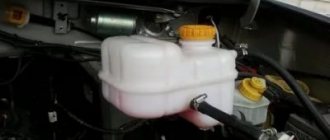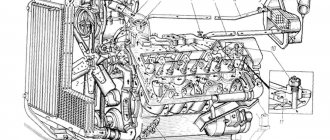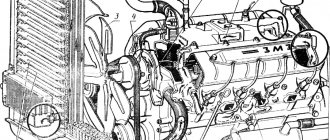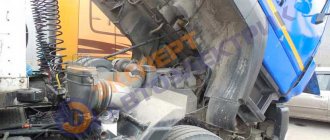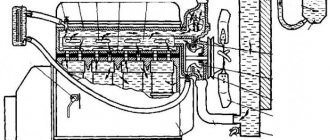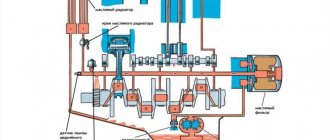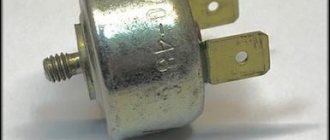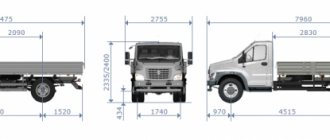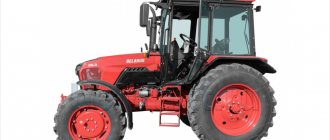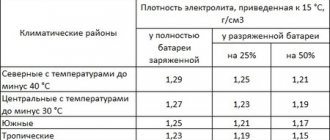Engine cooling system D 240 - radiator, pump and thermostat MTZ-82
The cooling system of the D 240 engine of the MTZ 82 tractor is closed, with forced circulation of liquid. The cooling system consists of the following main components: water pump (pump), thermostat, water radiator, fan, curtain, thermometer, and also includes drainage and water supply pipes, connecting fittings, hoses, drain taps, etc.
Cooling system diagram: 1 — radiator cap; 2— radiator; 3 - water supply pipe; 4 — thermostat; 5 - thermometer; 6 - water pump; 7 — drainage pipe; 8 - fan; 9 — curtain; 10 — faucet for draining water from the radiator.
How to replace a ZIL Bychok thermostat
Useful tips for do-it-yourself car repairs.
Recommendations from car service specialists and experienced car owners.
Useful tips on car repairs for ordinary drivers and professionals. All the necessary information about repairing and maintaining your car is available in e-books
and
regular printed publications
. Electronic manuals are convenient to use on a computer, smartphone or tablet. They will always be at your fingertips.
Zil Bychok cooling system part 1
how to remove the thermostat ZIL - 130
We will cook whatever we eat. WhatsApp 8-705-576-17-43. mail
The D 245 engine does not heat up, it seems like a victory!
Second attempt to find out why the engine is boiling? Moreover, it boils ONCE and then the thermostat works...
Maz 4370 Zubrenok thermostat replacement
changing the thermostat MAZ Zubrenok engine d 245 euros 2.
Thermostat. Design and testing.
If the engine is not prone to boiling, then for the winter you can set the thermostat to 92°. This will help…
The same ZIL. Thermostat. Generator. The same Zil. Thermostat. Generator..
Don’t forget to seal everything with sealant when assembling.
Correct connection of the stove on D-245
If the heater does not heat well on a bull, Valdai, Zubrenka MAZ 4370, PAZ, ZIL with an MTZ D245 engine - watch this...
(Zubrenok) - Nim Zhiguli in D245
If the design engineers foresaw everything, the factory did the opposite. The cause of the malfunction is...
Replacing the thermostat
Replacing a thermostat in extreme conditions seems to me to be quite simple. Replacing a thermostat is…
Varieties
Manufacturers equip cars with different types of temperature controllers.
This is due to engine power, the internal pressure of the cooling system, and the volume of liquid. The main types include:
- A simple one-valve option. Is the most common. One valve regulates the temperature of the antifreeze until the power unit is completely warmed up, subsequently opening full circulation within the system.
- Two-stage. The operating principle is similar to a single-valve thermostat. The only difference is that the valve consists of 2 plates: small and large. Temperature adjustment occurs as the small diameter plate is opened. After reaching a certain degree, a large diameter plate opens. Such thermostats are often installed on cars with high pressure inside the cooling system.
- Two-valve. Thermal elements of this type were installed on Soviet cars. The principle of their operation is based on the operation of the main and bypass valves installed on the same stem. As it heats up, a small valve opens. At the same time, the large valve remains closed. After the antifreeze was completely heated, the bypass valve closed, opening the main and full circulation within the system.
- Electronic. New, modern type of thermostats. The system with the valve inside remained the same, a heating element was added to it and adjustment was made using the on-board computer.
The design of the thermostat has not changed for many years, proving its efficiency for cooling engines of any power.
How to install a thermostat on MTZ
0.5 mm more). -Heat the glass on a gas burner and very quickly insert the prepared thermostat into it until the latter rests against the lip of the glass. -After complete cooling, the thermostat should be pressed very tightly into the glass. -We collect and rejoice. My 417 engine warms up quickly and constantly maintains a temperature of just over 80 degrees, and this is at minus outside.
0.5 mm more). -Heat the glass on a gas burner and very quickly insert the prepared thermostat into it until the latter rests against the lip of the glass. -After complete cooling, the thermostat should be pressed very tightly into the glass. -We collect and rejoice. My 417 engine warms up quickly and constantly maintains a temperature of just over 80 degrees, and this is at minus outside.
I took a photo and will try to post it now :)
Now I’ll try to chemize one of the two thermostats :) and still, how will the Euro thermostat behave if it is turned upside down?
How to remodel a stove
The modification of the stove consists of increasing the tightness of the housing, since part of the air flow goes past the heat exchanger. The new casing is made of thin metal sheet. There are pipes for supplying warm air to the tractor driver’s feet and to the windshield. The inlet hole is covered with a shield with slots. This allows you to reduce the amount of dust drawn into the cabin. The end edges of the radiator are covered with a layer of insulating material, thereby reducing heat losses. The joints of the body parts are welded, which reduces the repairability of the unit.
The standard valve loses its seal during operation - tractor drivers are forced to work on the machine in the summer with the heat exchanger of the stove turned on. A new valve eliminates the problem, but after several cycles of use the leak appears again. The modernization consists of installing an additional ball-type valve, which allows you to regulate the intensity of liquid flow through the heat exchanger.
Basic device malfunctions
The main signs that the unit has failed are the following:
- Diesel takes a long time to heat up to the optimal temperature, and its overheating occurs very quickly;
- The temperature indicators of the power plant fall while driving, and rise when stopping;
- When the engine warms up, the lower pipe remains warm for several minutes;
- The engine is very hot, and the lower pipe is consistently cold, even when the diesel engine is warm.
Problems and malfunctions in the system
A sign of a system malfunction is engine overheating. The first reason may be a decrease in the coolant level as a result of leaking rubber connecting pipes. After identifying the cause of the leak, it is eliminated by tightening the sealing clamps or replacing the pipes if they break.
Attention! To check the fluid level, open the radiator cap carefully, as boiling water can splash out of the neck and cause burns. Before opening, allow the engine to cool slightly, then, standing on the windward side wearing protective gloves, open the lid.
Poor tension or broken pump and fan drive belt
The cause of diesel overheating may be insufficient performance of the water pump and fan as a result of slipping of the drive belt drive. Eliminate slipping by adjusting the belt tension. When installing or tensioning the fan belt in MTZ-80(82), the degree of tension changes by shifting the position of the generator, since the unit pulley simultaneously serves as a tensioner for the entire drive. To adjust, the generator mounting nut is loosened and the degree of tension is changed by shifting its housing. After setting the desired tension, the position is fixed by tightening the generator mount.
The belt deflection in the area “from the generator pulley to the crankshaft pulley” should not exceed 10-15 mm when pressed with a finger with a force of 30 - 50 N. The tension is checked every 60 hours of operation. Excessive tension leads to increased wear on the bearings and drive belt. Poor tension leads to engine overheating and belt wear due to slipping.
Radiator cleaning
Contamination of the radiator from the outside impairs the heat transfer of the unit. Cleaning of dust and removal of crop residues trapped in the radiator mesh and the gaps between the tubes of the unit is carried out with a stream of compressed air. It is also necessary to prevent oil and fuel from coming into contact with the working surface of the assembly, since oil deposits will provoke the adhesion of dust, reducing its heat transfer.
Incomplete opening of the thermostat valve
Failure of the thermostat results in the system operating on a short “heating” cycle. You can verify that the thermostat valve has failed by checking the temperature of the pipes and the lower tank of the radiator. If the engine is heated and continues to gain temperature at idle, while the lower radiator tank does not heat up and the pipes are cold, it means that the valve does not operate and does not allow fluid to pass through the large cycle. In this case, the thermostat valve is removed and replaced.
Pump failure
A grinding and squeaking sound when the pump rotates, as well as the appearance of leaks and play on the rotation axis, indicate a failure of the unit. The cause of water pump failure may be wear of the axle bearings and failure of the unit seals. The reasons for rapid wear may be excessive tension on the drive belt, increasing the force on the bearings, or untimely lubrication. The pump is lubricated through a grease fitting during each maintenance 1 and maintenance 2. Replacement of failed seals and bearings is eliminated by dismantling the unit with complete disassembly.
Flushing the cooling system
The efficiency of the system is reduced as a result of the formation of heat-insulating scale on the walls of the engine water jacket. Thus, with a deposit build-up of 1 mm, fuel consumption increases by 8%, and with an additional build-up, the temperature of the cylinder-piston group parts increases. Scale reduces the permeability of the water jacket channels, disrupting circulation. Periodically, after 1000 operating hours or during seasonal maintenance, preventive flushing of the system is carried out. At the first stage, they are washed with water, removing sediment and rust. At the second stage, a solution is poured, which includes 750 grams of caustic or washing soda, 250 grams of kerosene per 10 liters of water. They work with the solution in the system for 7-8 hours, then replace the reagent with water and work for 5 minutes, then drain it. Finally, the shirt is washed 2-3 times with water.
System integrity violations
The most serious failure in the system may be depressurization as a result of cracks in the water jacket or metal-asbestos gasket between the engine block and the cylinder head. As a result of the violation, liquid may enter one of the cylinders, which will be indicated by steamy white exhaust gases. Liquid can also enter the lubrication system and drain into the engine sump. If the cylinder head gasket is damaged as a result of exhaust gases breaking through into the cooling system, excess pressure occurs and the temperature rises. In all the described cases, it is recommended to turn off the engine until the problem is detected and corrected, since operation on an overheated engine leads to wear, burnout or jamming with destruction of the block and parts of the cylinder-piston group.
Diesel engine MTZ 80
Tractors
The MTZ-80 power unit serves as the engine for the famous Belorus universal row-crop tractors. Due to the high power, traction and performance of this engine, the Belorus tractors are capable of cultivating large plots of land for a long time. Further in the article we will look at the engine characteristics, main advantages and functions.
Engine characteristics
The power unit is a 4-stroke engine with four cylinders, brands D-240 and D-243. The engine uses diesel fuel as fuel. The installed engines belong to the 4Ch11/12.5 family. The production of engines for Belorus was carried out at the Minsk Motor Plant.
The working surface of the engine was 4.75 liters. The power unit produced 82 units of power at 2200 rpm. The motor weighed 430 kg. The engines in question were equipped with a semi-divided combustion chamber, which was located in the piston. The engine was started in two ways.
- Due to an electric starter (for engines version D-240/243).
- Due to the carburetor engine, the power of which was 10 hp. The PD-10 engine was equipped with versions of the 240-243 L power units. The operation of both the starting and main engines was controlled from the tractor driver’s cab. Thanks to a special lock, the engine cannot be started at speed.
Not available:
| № | Part code | Name | Quantity per model, pcs. | |
| 245-1306030-A | Installing the Thermostat Housing | 1 | Not available | |
| 245-1306040 | Thermostat housing | 1 | Not available | |
| 1 | M8x25 | Bolt | 1 | Not available |
| 2 | M8x95 | Bolt | 1 | Not available |
| 3 | 50-1401067 | Washer | 4 | Not available |
| 4 | 50-1306026 | Pad | 1 | Not available |
| 5 | M8x25 | Bolt | 4 | Not available |
| 6 | 50-1401067 | Washer | 4 | Not available |
| 8 | KG3/8-A12-016 | Cork | 1 | Not available |
| 9 | TA107-04 | Solid thermostat | 1 | Not available |
| 9 | TR4-02 | Solid thermostat | 1 | Not available |
| 10 | 245-1306023 | Pad | 1 | Not available |
| 13 | 80-3801092-B | bracket | 1 | Not available |
| 14 | 50-1306028-B3 | Hose | 1 | Not available |
| 14 | 50-1306028-B4 | Thermostat hose | 1 | Not available |
| 15 | 20-32NORMA-TORRO | Clamp | 2 | Not available |
| 15 | XC-26-019 | Clamp | 2 | Not available |
Can't find the required part from the Thermostat group for MTZ-80 (2009) ? Consult our specialists by phone 8-800-700-19-88 or by email. We will definitely help you!
